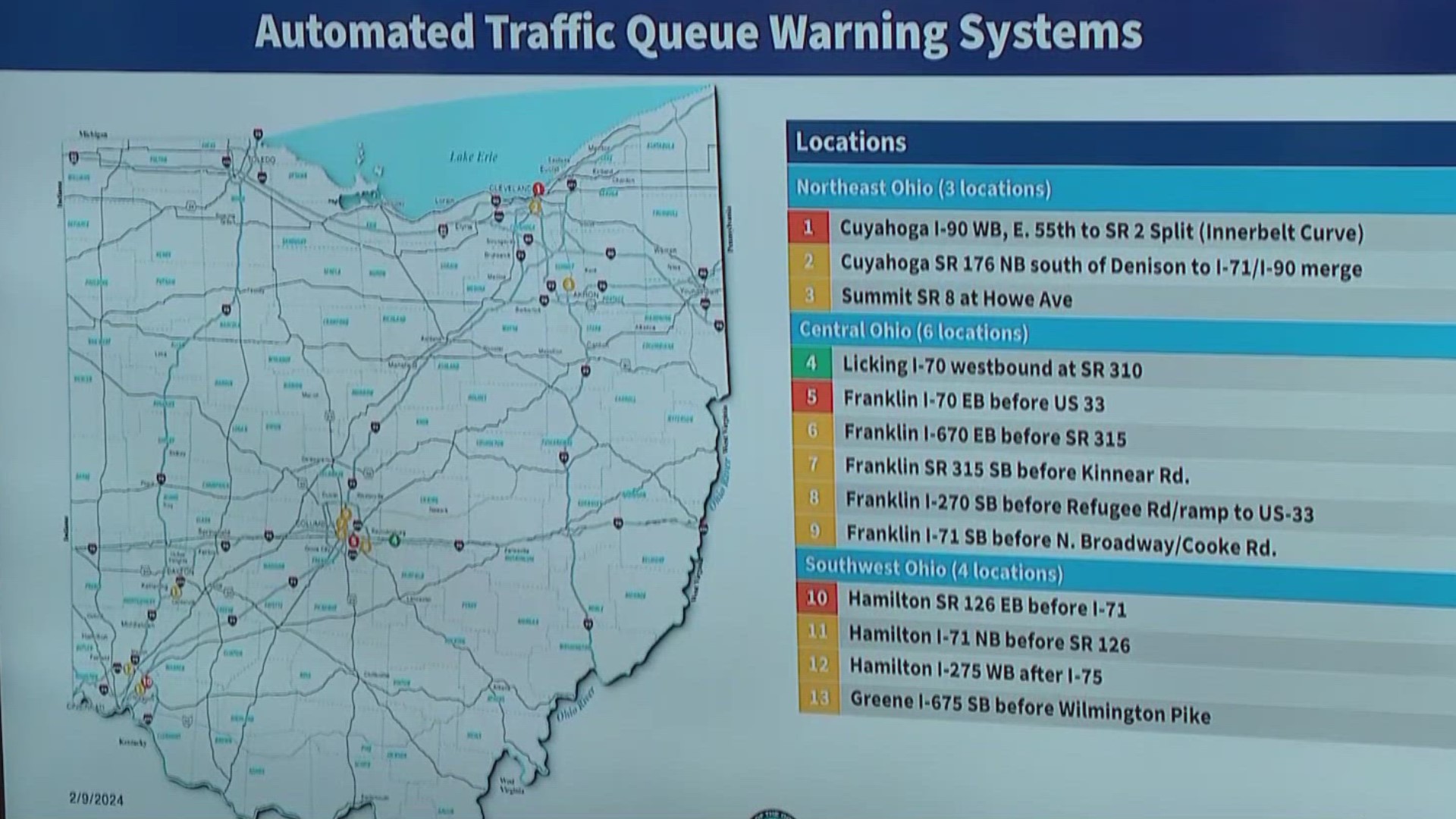COLUMBUS, Ohio — The state of Ohio is making new efforts to help reduce serious crashes on highways across the state as Gov. Mike DeWine announced plans to install "state-of-the-art technology" at 13 sites that will automatically alert drivers of slow or stopped traffic.
"The advanced cameras monitoring live traffic that feed into ODOT’s Traffic Management Center will detect in real time when traffic is slowing down and backing up," Gov. DeWine said during a press conference in Columbus on Thursday morning. "The technology will then immediately turn on a digital message warning drivers approximately two miles back of the upcoming slow down.”
You can watch the full press conference in the video below:
Once the technology is installed at all 13 locations, Gov. DeWine said ODOT anticipates this technology will reduce rear-end crashes on our highways by about 16 percent.
"These 13 sites were picked based upon the data that we have that indicates they are the most likely places to have serious rear-end crashes," Gov. DeWine explained.
Where can you expect these new signs? Here's a list...
NORTHEAST OHIO: 3 LOCATIONS
- Cuyahoga County: I-90 West, E. 55th to SR 2 split (Innerbelt Curve)
- Cuyahoga County: SR 176 North south of Denison to I-71/I-90 merge
- Summit County: Route 8 at Howe Avenue
CENTRAL OHIO: 6 LOCATIONS
- Licking County: I-70 West at Route 310
- Franklin County: I-70 East before US 33
- Franklin County: I-670 East before Route 315
- Franklin County: Route 315 South before Kinnear Road
- Franklin County: I-270 South before Refugee Road/ramp to US 33
- Franklin County: I-71 South before N. Broadway/Cooke Road
SOUTHWEST OHIO: 4 LOCATIONS
- Hamilton County: Route 126 East before I-71
- Hamilton County: I-71 North before Route 126
- Hamilton County: I-275 West after I-75
- Greene County: I-675 South before Wilmington Pike
ODOT activated one of the sites Thursday morning along I-70 West at Route 310 in Licking County.
"This is, of course, near where the Tuscarawas Valley charter bus crash happened," Gov. DeWine said while citing the November incident in which six people were killed. "When selecting this and the other 12 sites, ODOT looked at factors such as rush hour traffic backups and the number and the severity of rear-end crashes. We believe this new technology will, in fact, work."
When asked if that specific location was chosen in response to the deadly bus crash, ODOT Director Jack Marchbanks said: "It was already in the works. This accelerated it."
Here is a look at the new warning sign along I-70 West:


HOW IT WORKS & WHAT'S NEXT
"The automated traffic queue warning systems use similar technology to ODOT's wrong-way driver detection systems currently in place in Cincinnati, Dayton and Columbus that alert drivers who mistake exit ramps for on-ramps," according to a press release from Gov. DeWine's office. "So far, these systems have detected nearly 300 wrong-way drivers."
Gov. DeWine said it will take several years to get all of these systems installed, but he's already looking to the future by asking ODOT to identify more potential locations.
"When accounting for the time necessary to run needed electrical and broadband infrastructure to the 12 remaining automated warning system sites, ODOT expects all systems to be operational within two years," according to the state's press release.
DATA & MORE
"I think we’ve all been in a situation, particularly when we’re out on the interstate or highway, when traffic stops quickly -- and then your concern is you keep looking in your rearview mirror worried about someone that’s going to come up and is not going to be able to stop," Gov. DeWine said.
Last year there were more than 8,800 highway rear-end crashes, according to data provided by Gov. DeWine.
“We believe that distracted driving is a major reason why some drivers don’t slow down," he said. "Just not paying attention. Although we know that the new distracted driving law in Ohio is helping to reduce these and other types of traffic crashes. We’re also turning to technology to help.”
This new plan comes more than four months after Ohio began enforcing the state’s new distracted driving law. That law designates “the use of cell phones and other electronic communications devices while driving as a primary traffic offense for all drivers and allows law enforcement to immediately pull over a distracted driver upon witnessing a violation,” according to Ohio Gov. Mike DeWine’s office.
Citing data from the Ohio State Highway Patrol, Gov. DeWine's office says the new distracted driving laws "are influencing safer driving behavior" with 15,500 fewer traffic crashes in 2023 when compared to 2022.
MORE FROM 3NEWS...
- Ohio's new distracted driving law reaches next phase as police can begin issuing citations: Here are the exceptions
- Gas prices jump 15 cents in Cleveland, 12 cents in Akron: Here's what GasBuddy is saying
- Willoughby Hills police using high-tech laser cameras to target speeding drivers on I-90 and I-271

